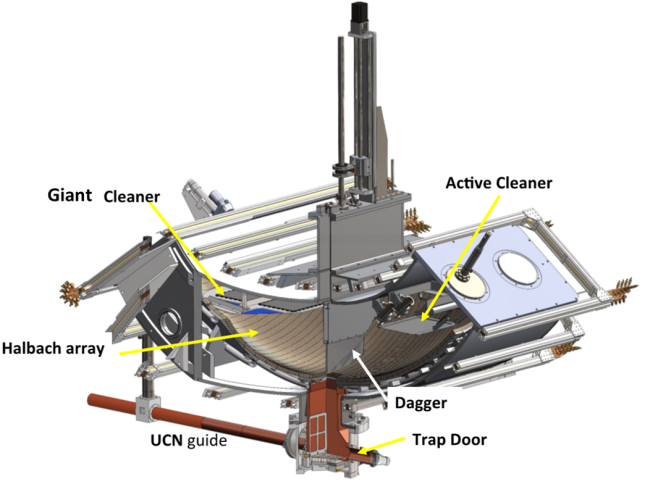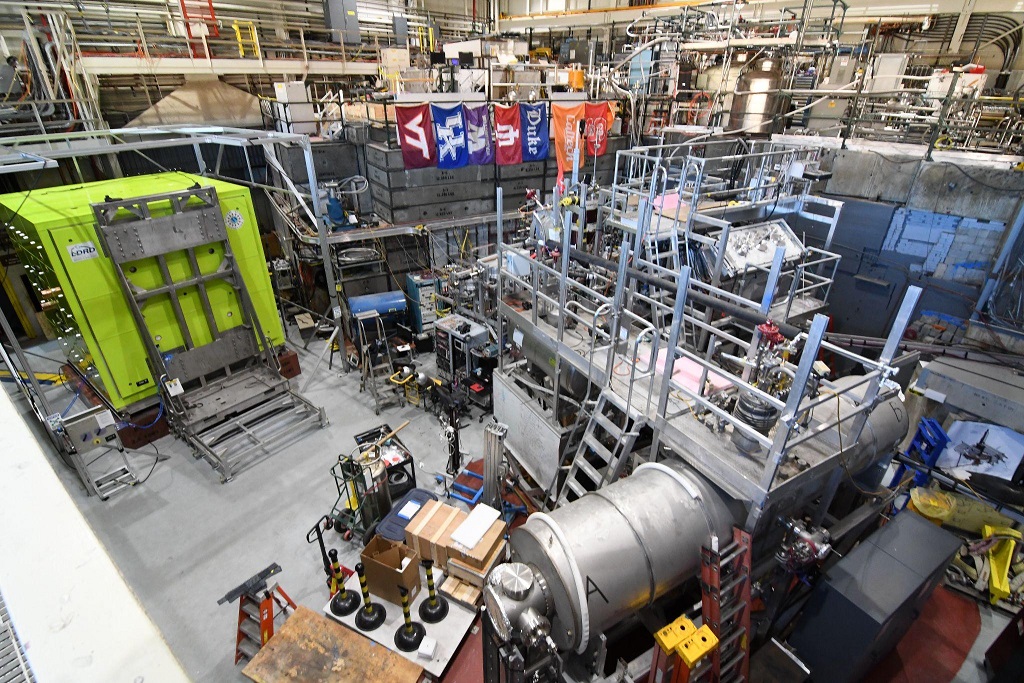The UCNtau experiment was motivated by the neutron lifetime puzzle, i.e., the two leading methods to measure the neutron lifetime give results that differ by 10 seconds!

The UCNtau experiment measures the neutron lifetime using magnetically trapped ultracold neutrons (UCN) at Los Alamos National Laboratory. This approach effectively eliminates the dominant source of loss and systematic uncertainty related to the absorption and upscatter from the UCN collisions with material surfaces. Magnetic trapping techniques exploit the repulsive force experienced by UCN polarized in the weak-field seeking state, F=μ ⋅ ∇B, effectively eliminating the dominant sources of loss from UCN storage experiment. The large volume of UCNtau, its asymmetrical construction, and its use of active neutron counting internal to the trap make UCNtau unique; its current results are at the level of the most precise experiments to date.
In the UCNtau trap, UCN approach the surface of the magnets, which cover the inner surface of a bathtub-shaped trap, and are reflected off by the strong repulsive magnetic force. As they move upwards, gravity slows them down and then pulls them back towards the magnets. As such, the combination of the magnetic and gravitational fields confine UCN inside an open-top, magnet-lined bathtub. Stored in this trap, UCN do not make contact with material, and are not subject to losses on material surfaces.
The UCNtau experiment uses UCN (with kinetic energies < 50 neV) in this Magneto-Gravitational (MG) trap. The experiment employs the "bottle" technique to store neutrons inside the trap for a duration and then count the number of surviving neutrons.

The Megneto-gravitational Trap:
UCN are levitated inside the trap by a strong magnetic force. We used more than 4000 permanent magnets made of NeBFe to line the inside of a bathtube-shaped trap. Inside this trap, the individual magnets are put together to form long magnetic strips. Between the stripes, the magnetization vector rotates by 90 degrees. This leads to a magnetic field that is highly non-uniform. The magnitude of the field decays exponentially away from the surface.
Here are some videos of testing this one-of-a-kind neutron trap:
Simulations of neutrons inside the trap:
Inside the trap, neutrons bounce around subject to the magnetic force from the magnets and the gravitational field of the earth. The motions of the neutrons are visualized below:
motion 1, motion 2 (simulations produced by Nathan Callahan).
Note that the motions of these two neutrons seem quite different. Why?
The different types of motion carry important consequences on the neutron lifetime experiment.
LANL UCN facility in Area B:
The UCNtau experiment takes place in the UCN facility at the Los Alamos National Laboratory (LANL).
Here is a recent (2022) photograph of the area.

Click here to watch some fun videos of what we do with UCN at LANL.
Here is a short article, "Goldilocks & the Three Bears" and the neutron lifetime measurements, sharing my experience measuring the neutron lifetime.
News Media Coverage on our UCNτ experiment:
See what others say about our fun research:
-
“Physicists make most precise measurement ever of neutron’s lifetime. But decades-long mystery of how long the particles live persists.” Davide Castelvecchi, 15 October 2021. https://www.nature.com/articles/d41586-021-02812-z
-
“Measuring the Neutron Lifetime with Record-Breaking Precision,” Shannon F. Hoogerheide National Institute of Standards and Technology, October 13, 2021, Physics 14, 142. https://physics.aps.org/articles/v14/142
-
“IU physicists lead world’s most precise measurement of neutron lifetime. The measurement will help put theories about the nature of the universe to the test,” Kevin Fryling, October 13, 2021. https://www.eurekalert.org/news-releases/931482; https://news.iu.edu/stories/2021/10/iub/13-physics-neutron-lifetime-measurement-study.html
-
“The Mystery of the Neutron Lifetime,” Shannon Brescher Shea, Office of Science’s Office of Communication and Public Affairs, September 2, 2020, https://www.energy.gov/science/articles/mystery-neutron-lifetime
-
“How long do neutrons live? Physicists close in on decades-old puzzle,” Alexandra Witze, April 15, 2019, https://www.nature.com/articles/d41586-019-01203-9
-
“IU physicists awarded $2 million to investigate neutrons,” Kevin Fryling, Sept. 12, 2018, https://news.iu.edu/stories/2018/09/iub/12-physicists-awarded-2-million-investigate-neutrons.html
-
“Using a ‘magneto-gravitational trap,’ IU physicists measure neutrons with unprecedented precision,” Kevin Fryling, May 15, 2018, https://news.iu.edu/stories/2018/05/iub/releases/15-using-magneto-gravitational-trap-physicists-measure-neutrons-with-unprecedented-precision.html
-
“Levitation yields better neutron-lifetime measurement,” Nancy Ambrosiano, May 10, 2018, https://www.lanl.gov/discover/news-release-archive/2018/May/0510-neutron-lifetime-measurement.php
-
“Despite a new measurement, the neutron’s lifetime is still puzzling,” Emily Conover, May 8, 2018, https://www.sciencenews.org/blog/science-ticker/new-measurement-neutron-lifetime-still-puzzling
-
“Neutron Lifetime Puzzle Deepens, but No Dark Matter Seen,” Natalie Wolchover, Feb 13, 2018, https://www.quantamagazine.org/neutron-lifetime-puzzle-deepens-but-no-dark-matter-seen-20180213/
-
“Neutron lifetime measurements take new shape for in situ detection,” American Institute of Physics, May 30, 2017, https://phys.org/news/2017-05-neutron-lifetime-situ.html
-
“Neutron Death Mystery Has Physicists Stymied,” Clara Moskowitz, May 13, 2014, https://www.scientificamerican.com/article/neutron-lifetime-mystery-new-physics/
Research Opportunities:
Our proposal to build the UCNtau+ experiment has just been fully funded by the LDRD program at LANL. At this point, we are looking for one postdoc, two graduate students, and a few undergraduate research assistants to join this effort. If you are interested, please contact us.
People currently on this effort:
- Chen-Yu Liu (PI)
- Maria Dawid (graduate student)
Ph.D. finished on this project:
-
Francisco Gonzalez, Ph.D. 2021 “Precision Measurement of the Neutron Lifetime with the UCNtau Experiment” (2015–2021); now a postdoc at the Oak Ridge National Laboratory
-
Nathan Callahan, Ph.D. 2018 “Measurement of the Neutron Beta Decay Lifetime Using Magnetically Trapped Ultracold Neutrons” (2012–2018); now a postdoc at Argonne National Laboratory
-
Even Adamek, Ph.D. 2017 “Measurement of the Neutron Beta Decay Lifetime Using Magnetically Trapped Ultracold Neutrons” (2011-2017); now a postdoc at the University of Mainz, Germany
-
Daniel Salvat, Ph.D. 2015 “A Magneto-Gravitational Neutron Trap for the Measurement of the Neutron Lifetime” (2009-2015); now a research scientist at Indian University
